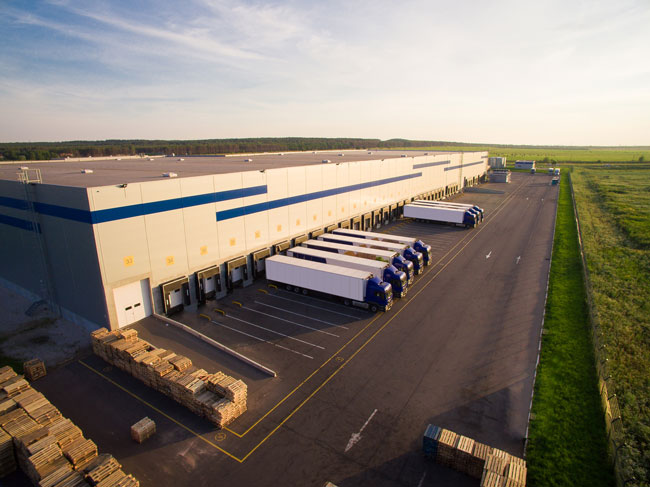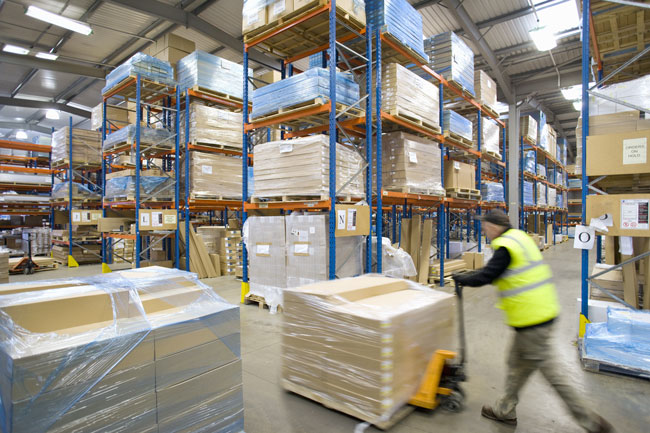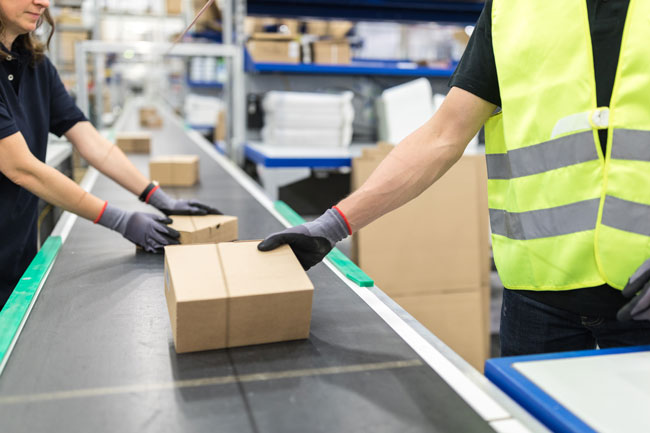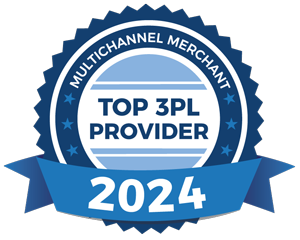Fulfillment Center vs. Warehouse – What’s the Difference?
Warehouse. Distribution center. Fulfillment center.
Although the terms seem similar and many people often interchange them, they each serve a distinct purpose and are quite different from each other. For example, a fulfillment center has much greater capabilities. Let’s break down the functions of each to better understand their roles in the fulfillment supply chain.
What Is a Warehouse?

The traditional supply chain from decades ago brought about the need for warehouses. Their job was, and still is, to store high volumes of inventory for long periods of time.
The day-to-day activity at warehouses is considered fairly static – new inventory comes in, product may be moved to a different location within the warehouse, and some product might ship out. There’s not a lot a lot of hustle and bustle, it’s very static and systematic.
Thanks to ecommerce, the average footprint of warehouses built in the U.S. has more than doubled since the early 2000s. And according to Supply Chain Dive, light industrial warehouses between 70,000 – 120,000 sq. ft. are currently the most sought after. They saw the most demand, lowest availability, and highest growth rate between 2014-2019.
What can get stored at a warehouse? Pretty much anything. Finished goods, merchandise, or raw material will remain stored at a warehouse, sometimes for months, until it needs to be shipped to another source like a retailer, wholesaler, or distribution partner. Most warehouses serve the wholesale or business-to-business market. Rarely will a warehouse service the public/customer directly.
There’s a wide variety of warehouses to suit different storage needs. Some of the most common types are public warehouses, private warehouses, bonded warehouses, co-op warehouses, and smart/automated warehouses.
Warehouse Recap:
- Store high-volume inventory for extended time periods
- Static operation
- Primarily serves wholesale, B2B markets
- Most in demand – 70,000-120,000 SF light industrial warehouses
- Many types to choose from
What Is a Distribution Center?

Let’s take a closer look at a distribution center vs. warehouse. As supply chains have become more sophisticated with a greater need for speed and inventory accessibility, distribution centers have grown in popularity. Perhaps they can be best described as a fast-moving warehouse, but they also function in ways that a traditional warehouse does not.
Distribution centers are demand-driven facilities designed to receive, temporarily store, and redistribute product fast. They’re relied on heavily by online retailers and ecommerce brands. Many retailers will ship product directly to a distribution center instead of warehouse, and then product can be shipped directly to the customer.
In addition to storing fast-moving inventory, most distribution centers are also equipped to process products, create SKU assortments, and assemble shipments. Some will have climate-controlled space for the special handling and storage of refrigerated, frozen, or temperature-sensitive products.
Lastly, distribution centers are usually part of a bigger distribution network, with locations strategically located to get product to any corner of the country fast. A customer’s order can be shipped out from the distribution center closest to the order’s final destination.
Distribution Center Recap:
- Shorter-term storage
- Demand-driven – receive, store, redistribute product
- Ships product directly to customers
- Can process products, create SKU assortments, assemble shipments
- Strategically located for faster shipping
What Is a Fulfillment Center?
We’ve looked at a distribution center vs. warehouse, now let’s compare a fulfillment center vs. warehouse and distribution center.
The capabilities of a fulfillment center go far beyond those of a warehouse or distribution center. Also known as a Third-Party Logistics (3PL) provider, a fulfillment center has the important role of not only receiving and storing inventory but also receiving, processing, and shipping customer orders. While a warehouse has static operations, a 3PL has the opposite. Its operations can sometimes be 24/7 with lots of fluid activity.
3PLs are equipped to service a wide range of customers including B2B, retailers, ecommerce companies, and direct to consumer. No matter which type of customer they are working with, a 3PL’s main job is to get orders delivered to customer as fast as possible.
The 5 key operations that a fulfillment center handles include:
Receiving
The order fulfillment process starts with receipt of inventory, which is pre-marked with a unique bar code identifier (UPC/EAN or SKU) that the customer provides per the 3PL placement guidelines. All product is counted, verified and quality-checked for any damage issues.
Storing inventory
A 3PL will then configure its inventory from highest-picked to least-picked, positioning top-selling inventory in a location that’s more easily accessible than slower-moving product. Having good inventory storage and management operations is the key to effective ecommerce fulfillment.

Processing ecommerce fulfillment orders
3PLs process and fill custom orders by integrating a seller’s ecommerce shopping cart or other platform with their own fulfillment software. At PFC Fulfillment, we’re connected with one of the most comprehensive lists of fulfillment integration providers and are always expanding.
Shipping
A fulfillment center works with all the major shipping carriers like FedEx, UPS, and USPS to ship orders to customers. Their established network gives them access to more frequent and flexible shipping options, and their high-volume shipping power gives them the ability to cut shipping costs, often by as much as 35-50%.
Returns Processing
Most 3PLs have the ability to manage the returns process of ecommerce fulfillment orders. With online returns increasing by more than 50% in recent years, it’s quickly become a critical operation within the fulfillment process. The key aspects of a reverse logistics program include the management of customer return labels, product inspection upon return, credit reconciliation, product disposition, product repackaging, and restocking or disposal.
In addition to the above functions, many fulfillment centers also have custom kitting and assembly capabilities like custom packaging, personalization, or subscription box services. Some also offer customer support services via a call center with trained agents who manage inbound and outbound calls and emails for B2B and B2C customers.
Besides the benefits of faster shipping and cost savings, working with a 3PL delivers other big benefits when it comes to your fulfillment operations:
- Industry expertise that drives greater efficiency in your ecommerce fulfillment chain
- More time to focus on core aspects of your business
- Robust and real-time analytics for all aspects of the fulfillment chain
- Scalability in warehouse space, staffing, etc. as your business grows and changes
Fulfillment Center Recap:
- Fast-turn inventory getting shipped to customers as quick as possible
- Full-service order fulfillment – receive/store inventory, process/pack/ship orders
- Works with B2B, retailers, ecommerce brands, direct to consumer
- Scalable operations
- Fast shipping, cost savings
Contact PFC Fulfillment
If your current business needs more than just additional storage for your products, then it might be time to consider a full-service fulfillment center. Contact PFC Fulfillment today if you’d like to learn more and start a conversation.

